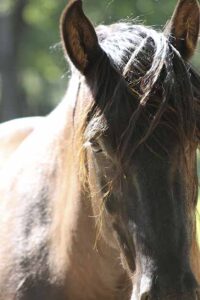Facial Expressions: What Can A Horse Grimace Scale Tell Us?
Rutgers University Equine Quarterly, Summer 2022:
From the Lab- Facial Expressions: What Can A Horse Grimace Scale Tell Us?
Top Takeaways:
- Horses have 17 facial action units, which they use to generate a rich catalogue of facial movements. This is quite close to us- we have 27. Chimpanzees and rhesus macaques only have 13!
- Equine behavioral research has exploded in recent years as attention on equine welfare has increased. Because of this, we now have access to several ethograms, scales, and other metrics that allow us to categorize and analyze equine behaviors.
- The impacts of Equine-Assisted Interventions (EAIs) on humans are well-studied (and overwhelmingly positive!), but the impacts on horses are not as well studied. Existing literature on the subject remains fairly inconclusive.
- The Horse Grimace Scale was created during a 2014 study evaluating the facial behaviors of 40 stallions undergoing castration with varying levels of analgesics. It allows users to assign a numerical score to the amount of muscular tension exhibited in the equine profile.
One of the most endearing qualities that our equine friends possess is their expressiveness. Sometimes goofy but always charming, horses can exhibit a strikingly large repertoire of facial behaviors while communicating with us.
Until recent years, the meaning of many of these behaviors has remained a mystery, but with the advent of new research, several metrics have been developed that can enable us to both identify and analyze equine facial behaviors. One of these metrics is the Horse Grimace Scale.
Developed through a 2014 study by Emanuela Dalla Costa and her team of researchers, the scale is designed to measure the amount of muscular tension held in six discrete facial action units (FAUs) visible on the equine side profile: stiffly backwards ears, orbital tightening, tension above the eye area, prominent strained chewing muscles, mouth strained and pronounced chin, strained nostrils and flattening of the profile. Each FAU is scored using an integer between 0-2, with higher numbers correlating to higher levels of muscular tension. This means that a horse can score a maximum of 12/12 on the scale, indicating high levels of muscular tension across the face; this is in turn associated with the horse experiencing a higher degree of pain.
The idea of utilizing muscular tension as the physical manifestation of equine distress is a fairly novel concept; in 2019, Rutgers ESC researcher Ellen Rankins investigated the links between muscular tension and acute stress in equine subjects, concluding the potential of a strong connection between increased levels of muscular tension and stress. Interestingly, the masseter muscle- a facial muscle primarily responsible for elevating and protracting the lower jaw- showed significantly altered surface electromyography values when horses were exposed to stressful procedures.
When the results of Ellen’s study are considered alongside other literature examining the link between muscular tension and equine distress, a compelling case emerges for using equine facial behavior as a tool for effectively measuring their stress levels.
The HGS was used to evaluate the facial behaviors of eight mature geldings of varying breeds and ages during a study investigating the levels of stress experienced by horses involved in an Equine-Assisted Intervention (EAI) for veterans with PTSD. While the positive impacts of EAIs on humans have been well-explored, there remains a good deal of uncertainty surrounding the impacts on equine welfare, particularly so for interventions involving patients with psychological disorders such as PTSD. In the study, four of the horses participated in an eight week EAI program, meeting with a veteran for one 30-minute session once a week. Concurrently, the other four horses served as controls, staying distanced from the EAI session in a square pen.
During each session, photographs of the profiles of both the EAI and control horse were taken at three timepoints, selected to be representative of the beginning, middle, and end of the intervention. The photographs were then organized to create a bank of data that was subsequently analyzed by five Rutgers undergraduates using the HGS. Across the sessions, EAI had no significant impact on mean HGS score (p = 0.4554); across the timepoints within the sessions, there was also no significant impact of EAI observed on mean HGS score (p = 0.7993). The interaction between EAI, timepoints, and sessions yielded no significant effect on mean HGS score as well (p = 0.4344).
The results of the study show that great potential lies in the use of the HGS for measuring levels of equine stress, and at the ESC work has already begun on adjusting scoring procedures to allow us to employ the HGS even more efficiently in the future.
Check out the Rutgers University Equine Quarterly, Summer 2022, below. You can find this article on page 14:
https://esc.rutgers.edu/wp-content/uploads/2022/08/Summer-2022-Newsletter-.pdf











